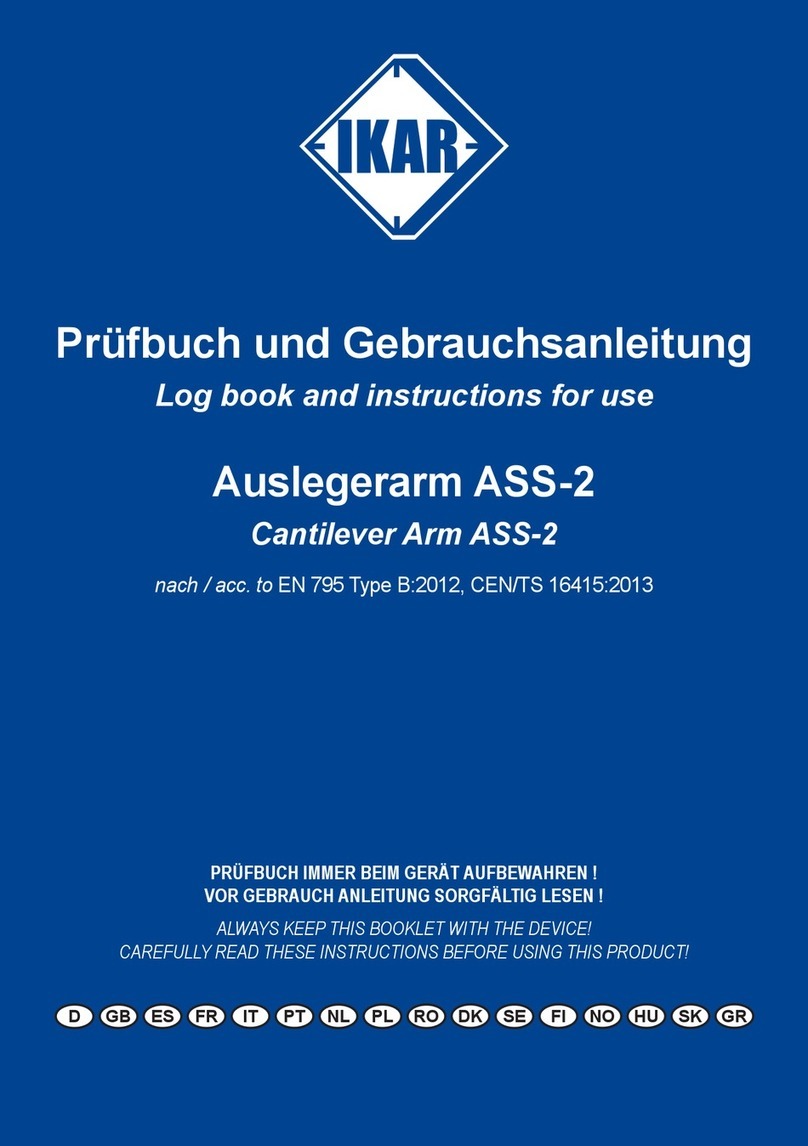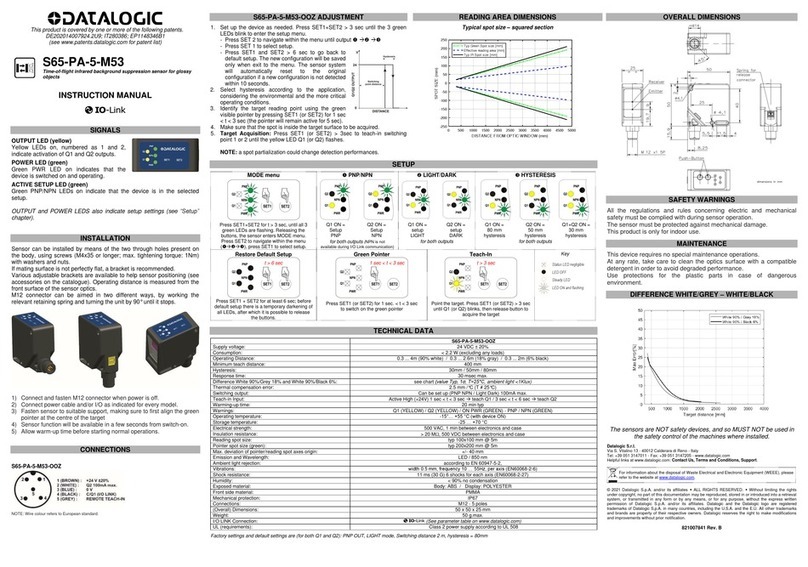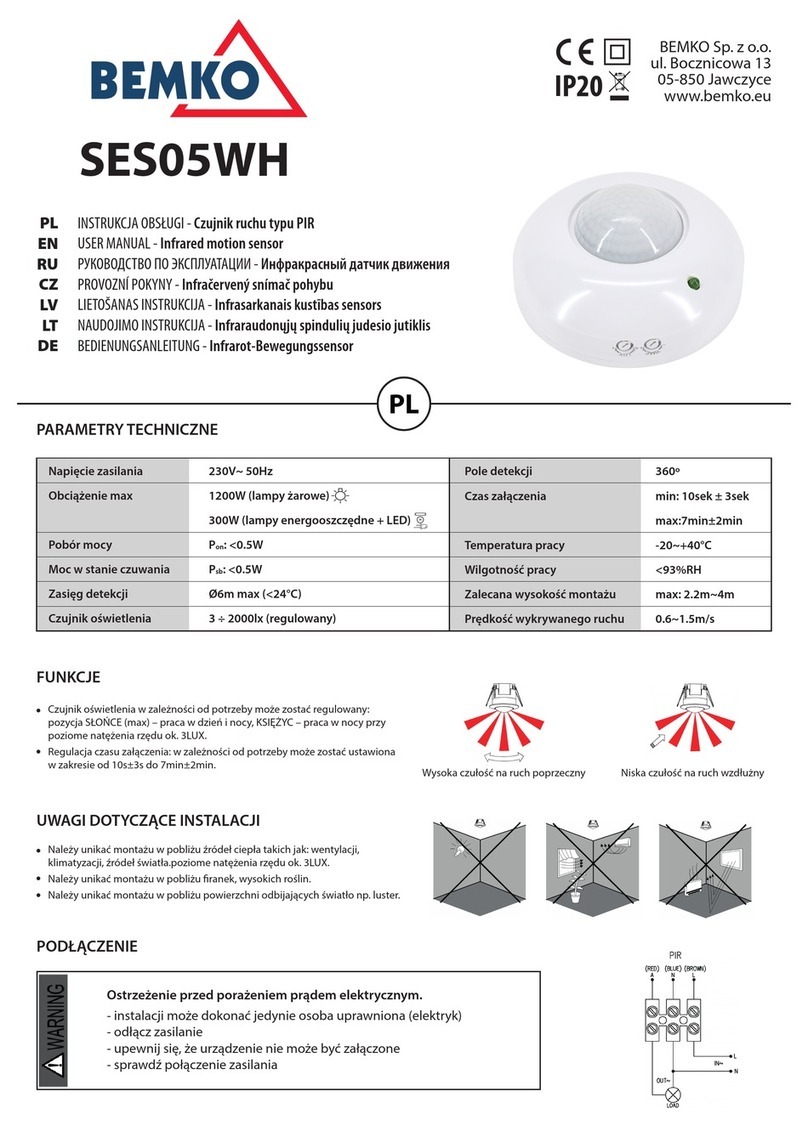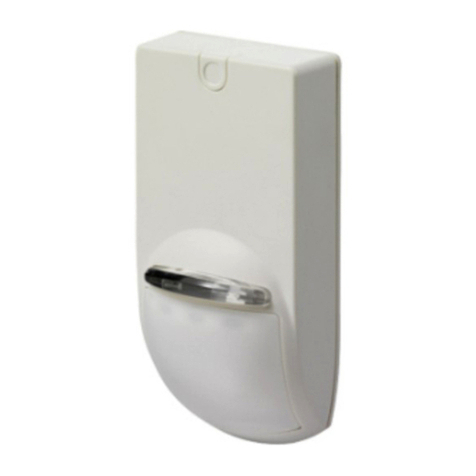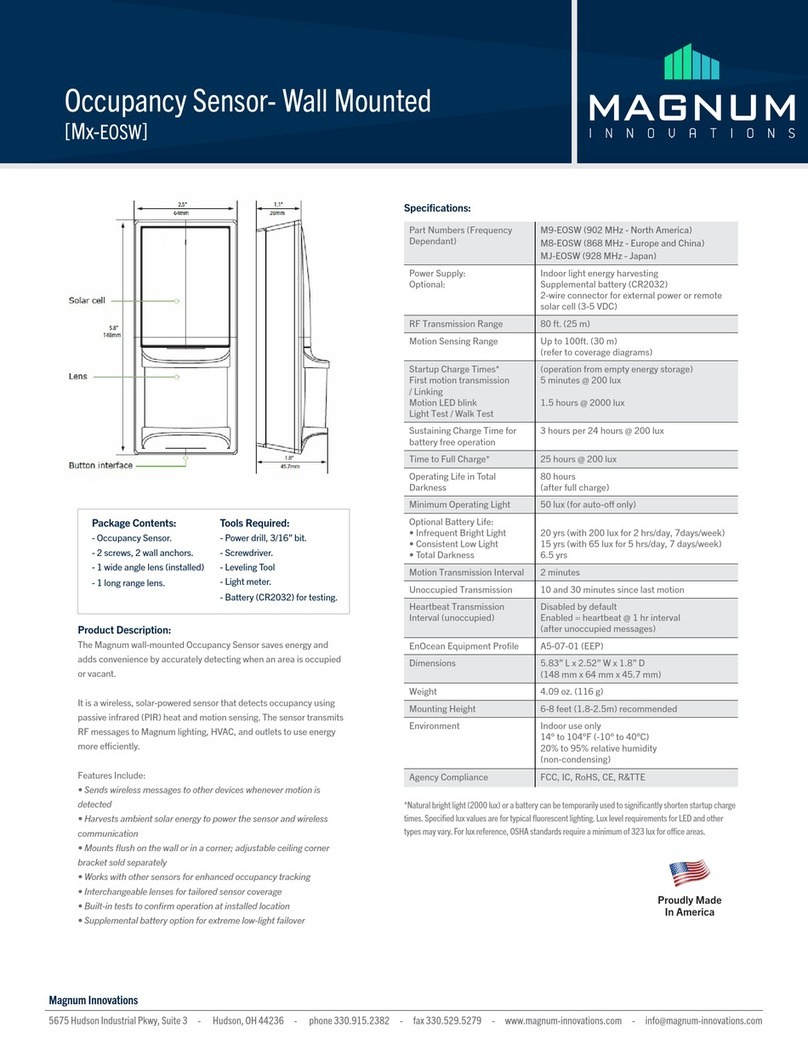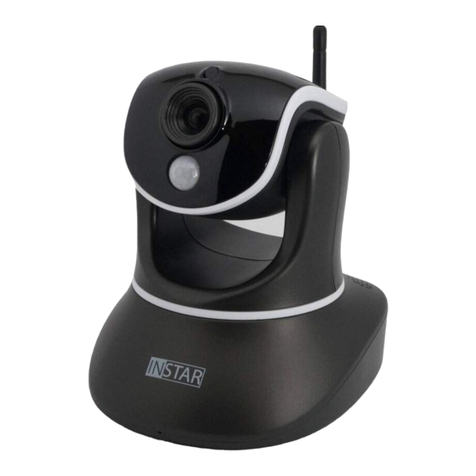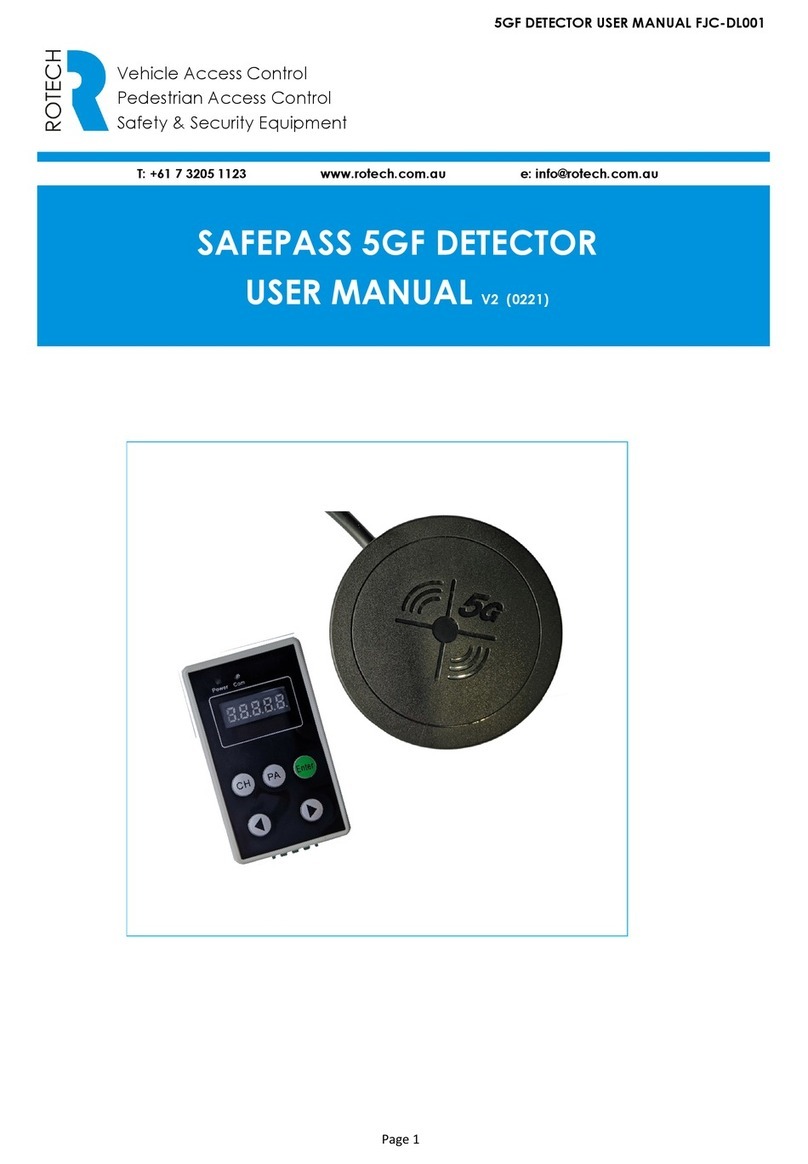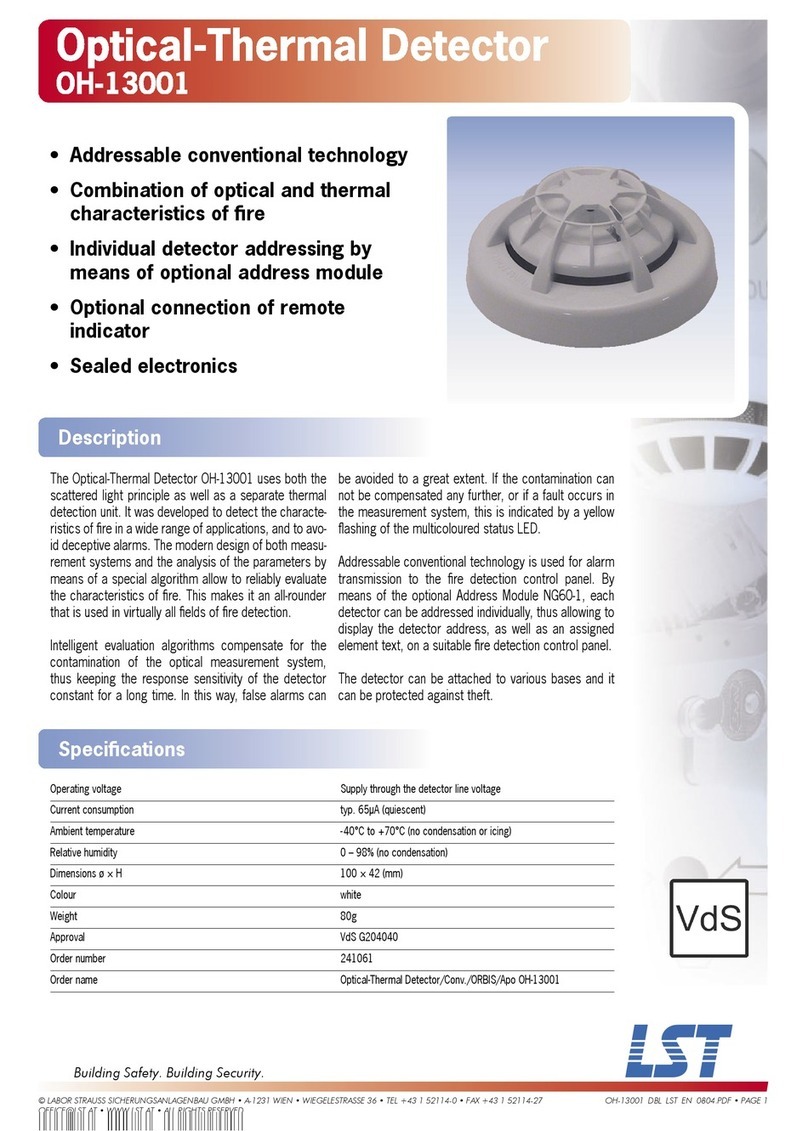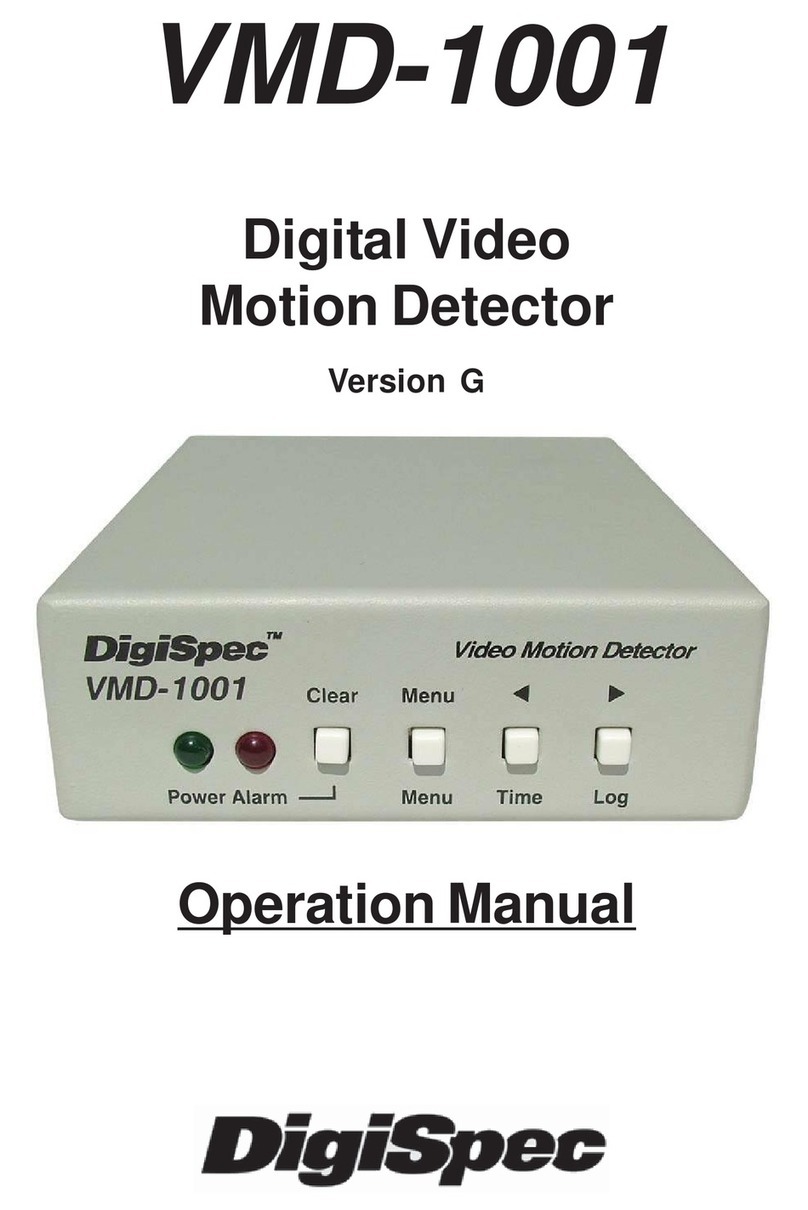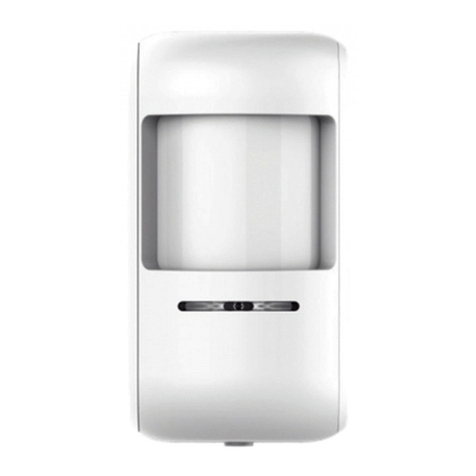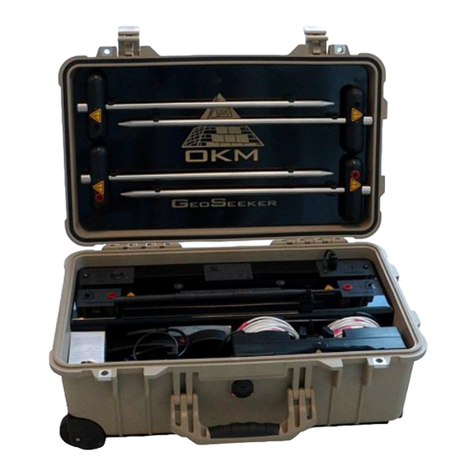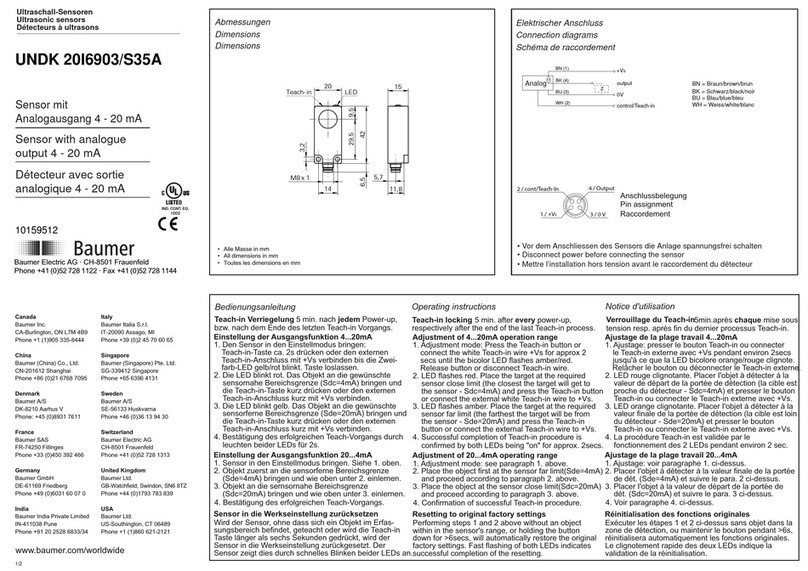IKAR HRA Series User manual

1
Prüfbuch und Gebrauchsanleitung
Höhensicherungsgerät HRA mit
Rettungshubeinrichtung
nach EN 360:2002 / EN 1496:2007 B,
CSA Z259.2.2-98ANSI/ASSE Z359.14-2014
Instructions for the use and inspection records
Fall Arrest Block HRA with recovery mechanism
in accordance with EN 360:2002 / EN 1496:2007 B,
CSA Z259.2.2-98ANSI/ASSE Z359.14-2014
PRÜFBUCH IMMER BEIM GERÄT AUFBEWAHREN !
VOR GEBRAUCH ANLEITUNG SORGFÄLTIG LESEN !
ALWAYS KEEP THIS BOOKLET WITH THE DEVICE!
CAREFULLY READ THESE INSTRUCTIONS BEFORE USING THIS PRODUCT!
HUNOFI
SE
DK
ROPLNLD PTIT
FRESGB SK GR

2 3
Kaufdatum/
date of purchase:
Datum der Erstbenutzung/
date of rst use:
Position / item
Bremseinstellung /
brake adjustment:
Seildurchmesser /
cable diameter:
Seillänge /
cable length:
Ansprechen der Klinken /
response of pawls:
Federeinzug /
Spring:
Karabinerhaken /
snap hook:
Ansprechlänge mit 35 kg /
response lenght 35 kg:
Auffangkraft /
catching power:
Seileinzug /
cable retraction:
Sichtkontrolle /
visual inspection:
Lesbarkeit Typenschild
readability label
Rettungshubfunktion / Kurbelkraft prüfen /
check recovery mechanism / crank force:
Datum der Abnahme / Date:
Unterschrift des Prüfers/ Sign:
Grund der Barbeitung/
purposes:
Festgestellte Mängel/
observed defects:
nächste jährliche Prüfung
next annual revision
Nr. - Jahr
No. - year
Nächste Prüfung Höhensicherungsgerät HRA mit Rettungshubeinrichtung nach EN 360:2002 / EN
1496:2007 B, CSAZ259.2.2-98 Typ 3, ANSI/ASSE Z359.14-2014
Fall Arrest Block HRA with recovery mechanism in accordance with EN
360:2002 / EN 1496:2007 B,CSAZ259.2.2-98 Typ 3, ANSI/ASSE Z359.14-2014
Eingeschaltete Stelle/ Certication body:
Prüf- und Zertizierungsstelle des FA PSA,
D-42781 Haan/ Germany, CE 0299
Konformitätserklärung/Conformity http://ikar-gmbh.de/index.php/de/service/download

3
Dieses Prüfbuch mit Bedienungsanleitung gehört zur PSA und muss am Einsatzort verfügbar sein.
Wird das Gerät wiederverkauft, muss diese Gebrauchsanleitung in Landessprache beigefügt sein.
This user manual and operating instructions are part of the safety system and all users should be
totally familiar with its contents. It should be kept in a safe place and be freely available to users at all
times.

4 5

5
Inhaltsverzeichnis
Content
Inhalt
Nächste Prüfung.........................................................................................2
Kennzeichnung - Typenschilder / Labeling - Type labels................................................... 6
DEUTSCH ....................................................................................................8
ENGLISH....................................................................................................12
FRANÇAIS.................................................................................................16
ESPAÑOL ..................................................................................................20
ITALIANO...................................................................................................24
POLSKI ......................................................................................................28
ROMANIA ..................................................................................................32
MAGYAR....................................................................................................36
NEDERLANDS...........................................................................................40
DANSK.......................................................................................................44
SVENSK.....................................................................................................48
SUOMEKSI ................................................................................................52
NORSK.......................................................................................................56
SLOVENSKO.............................................................................................60

6 7
HUNOFI
SE
DK
ROPLNLD PTIT
FRESGB SK GR
460CSA1224
Höhensicherungsgerät
mit Rettungshubeinrichtung
Typ: HRA XX
Hubnennlast: 136 kg
Seillänge: xxm
Max. Hubhöhe: xxm
Herstelldatum: xx/20xx
Seriennummer: 1234567
HRA Typenschild
46CSA1224
Layout date:
approved for print:
date: ____________________
signature: ____________________
6. Juli 2018
Text
Label Pantone 1795 C
Cut Contour
HRA12 HRA 12D HRA 12E HRA18 HRA 18D HRA 18E
HRA 18P HRA 18PD
EN 360:2002/ EN 1496:2007 B
nur für Rettungszwecke geeignet
for rescue purposes only
uniquement à des ns de sauvetage
Retractable type fall arrestor / Les appareil antichute, according to / selon la
EN 360:2002 / EN 1496:2007 B, CSA Z259.2.2 Type 3 & ANSI/ASSE Z359.14-2014 Class B
WARNING: Follow all manufacturers instructions included at the time of shipping.
AVERTISSEMENT: Respectez les instructions du fabricant incluses au moment de l‘expédition.
Nächste Prüfung
Next annual check
prochaine révision
RAL White Aluminium
IKAR GmbH · Nobelstrasse 2 ·36041 Fulda
GERMANY
Retractable type fall arrestor / Les appareil antichute, according to / selon la
EN 360:2002 / EN 1496:2007 B, CSA Z259.2.2 98 Type 3 & ANSI/ASSE Z359.14-2014 Class B
WARNING: Follow all manufacturers instructions included at the time of shipping.
AVERTISSEMENT: Respectez les instructions du fabricant incluses au moment de l‘expédition.
Kennzeichnung - Typenschilder / Labeling - Type labels
8
1
5
3
6
7
2
4
9
1
8
4
2
7
6
10
95
3
40 40

7
1
Überwachende Stelle · Monitoring body · Punto de supervisión · Autorité de surveillance · Ente di sorveglianza ·
Pontos a monitorar · Controleorgaan · Jednostka nadzorująca · Unitatea de supraveghere · Tilsynssted · Övervakningsorgan ·
Tarkastuslaitos · Tilsynssted · Felügyeleti szerv · Kontrolné pracovisko · Εποπτική αρχή
2
Seriennummer · Serial number · Número de serie · Numéro de série · Numero di serie · Pontos a monitorar ·
Número de série do aparelho · Seriennummer van het apparaat · Numer seryjny urządzenia · Seria echipamentului ·
Serienummer på grejet · Serienummer · sarjanumero · Serienummer · Sorozatszámot · výrobné číslo · Σειριακός αριθμός διάταξης
3
Typenbezeichnung · product type · Denominación del tipo · Code de désignation · Denominazione tipo · Designação do modelo ·
Typeaanduiding · oznaczenie typu · Denumirea tipului · Typebetegnelse · Typbeteckning · Tyyppimerkintä · Typebetegnelse ·
Típusmegnevezés · Označenie typu · Ονομασία τύπου
4Norm · Standard · Norma · Norme · Norma · Norma · Norm · Norma · Norma · Norm · Norm · Standardi · Norm · Norma · Norma ·
Πρότυπο
5
Nächste Revision · date of next inspection · Próxima revisión · Prochaine révision · Prossima revisione · Próxima revisão ·
Volgende revisie · następna kontrola · Următoarea revizie · Næste eftersyn · Nästa revision · Seuraava tarkastus · neste inspeksjon ·
Következő felülvizsgálás · Nasledujúca revízia · Επόμενη επιθεώρηση
6
Gebrauchsanleitung beachten · read the instruction manual · Prestar atención a las instrucciones de uso · Respecter la notice
d‘utilisation · Rispettare le istruzioni per l‘uso · Observar o manual do utilizador · Houd u aan de gebruiksaanwijzing · Przestrzegać
instrukcji obsługi · Respectați instrucțiunile de utilizare · Iagttag brugsanvisning · Följ bruksanvisningen · Käyttöohjetta noudatettava ·
Overhold bruksanvisning · A használati útmutatóban foglaltak betartandók · Dodržujte návod na použitie ·
Προσοχή στις οδηγίες χρήσης
7
Herstelldatum · Date of manufacture · Fecha de fabricatión · Date de fabrication · Data die construzione · Data de fabrico ·
Fabricagedatum · Data produkcji · Data fabricației · Produktionsdato · Tillverkningsdatum · Valmistuspäivä · Produksjonsdato ·
Gyártási dátum · Dátum výroby · Ημερομηνία κατασκευής
8Hersteller · Manufacturer · Fabricante · Fabricants · Costruttore · Fabricante · Fabricant · Fabrikant · Producenta · Fabricantului ·
Producent · Tillverkare · Valmistajan osoite · Produsent · Gyártói · Výrobcu · Κατασκευαστής
9
max. Tragkraft · Maximum lifting capacity · Capacidad de carga máx. · Capacité de charge max. · Portata max. · Capacidade
carga máx. · Max. draagkracht · maks. udźwig · Forță portantă max. · max. bæreevne · max. bärkraft · Enimm. kantokyky · maks.
bæreevne · max. terhelhetőség · max. nosnosť · Μέγιστη ικανότητα φορτίου
10
max. Belastung · max. Belastung · Maximum load · Carga máx. · Charge max. · Carico max. · Carga máx. · Max. belasting ·
maks. obciążenie · Solicitare max. · max. belastning · max. belastning · Enimm. kuorma · maks. belastning · max. terhelés · max.
zaťaženie · Μέγιστη επιβάρυνση
Hinweis: Geräte, die mit einem EN-Typenschild gekennzeichnet sind, dürfen nur in Länder verkauft und benutzt werden welche die EN-Norm anerkennen.
Note: Devices labelled with an EN type plate may only be sold and used in countries in which the EN standard is recognised.
Remarque: les appareils dotés d'une plaque signalétique EN doivent uniquement être commercialisés et utilisés dans les pays qui reconnaissent la norme EN.
Nota: los dispositivos que están marcados con una placa de características EN, sólo pueden venderse y utilizarse en los países que reconocen la norma EN.
Avvertenza: gli apparecchi con marchio di conformità EN possono essere venduti e impiegati solo nei paesi che riconoscono la norma EN.
Nota: Os equipamentos marcados com uma placa de identicação EN podem ser vendidos e usados apenas em países que reconhecem a norma EN.
Instructie: apparaten die met een EN-typeplaatje gemarkeerd zijn, mogen enkel in landen verkocht en gebruikt worden die de EN-norm erkennen.
Uwaga: urządzenia, które oznaczono tabliczką znamionową EN, można sprzedawać i z nich korzystać tylko w krajach, które uznają normę EN.
Indicaţie: Comercializarea şi utilizarea aparatelor marcate cu o plăcuţă cu caracteristicile EN sunt permise numai în ţările care recunosc directiva EN.
Bemærk: Anordninger, som er mærket med et EN-typeskilt, må kun sælges og anvendes i lande, som anerkender EN-standarden.
Obs: Enheter märkta med en EN-typskylt får endast säljas och användas i länder som godkänner EN-standarden.
Huomautus: EN-merkinnällä varustettuja laitteita saa myydä ja käyttää vain sellaisissa maissa, joissa EN-standardi on hyväksytty.
Merk: Enheter merket med en EN merkeplate kan kun selges og brukes i land hvor EN standard er anerkjent.
Felhívás: Az EN típustáblával jelölt készülékek kizárólag olyan országokban értékesíthetők és használhatók, melyek elismerik az EN normák rendelkezéseit
Poznámka: Zariadenie opatrené typu EN štítku môžu byť predávané a používané v krajinách, v ktorých sa norma EN uznávaných iba.
Οδηγία: Οι συσκευές που φέρουν το σήμα EN επιτρέπεται να πωλούνται και να χρησιμοποιούνται μόνο σε χώρες, οι οποίες αναγνωρίζουν το πρότυπο
αναγνωρίζουν το πρότυπο EN.
HUNOFI
SE
DK
ROPLNLD PTIT
FRESGB SK GR

8 9
Gebrauchsanleitung Sicherheitsbereich
1. Das IKAR Höhensicherungsgerät mit Rettungshubeinrichtung Typ HRA nach EN
360:2002 / EN 1496:2007 B, CSA Z259.2.2-98 Type 3, und Z359.14-2014 ist ein
automatisches Auffanggerät, Teilsystem einer PSA gegen Absturz mit integrierten,
falldämpfenden Funktionen als Auffang- und Rettungshubgerät. Das HRA-Gerät dient
in Verbindung eines Auffanggurtes (EN 361:2002 / EN 1497:2007, CSA Z259.10-06)
der Sicherheit von Personen bei Arbeiten, bei denen die Gefahr eines Absturzes be
steht. (z.B. beim Befahren von Behältern, Schächten, abwassertechnischen Anlagen).
Mit der Rettungshubeinrichtung wird im Notfall die verunfallte Person hoch gekurbelt.
Das Absenken der Person ist auf eine Strecke von 2 m begenzt (Abb.1). Das HRA-
Gerät darf nur bestimmungsgemäß verwendet werden.
2. Die Gebrauchsanleitung ist vor der Benutzung vollständig zu lesen und inhaltlich zuver
stehen. Bei Nichtbeachtung der Gebrauchsanleitung besteht Lebensgefahr
(Abb. 2).Im Falle eines Sturzes ist ein längeres Hängen der Person als 15 Minuten
auszuschließen (Schockgefahr).
3. Die Rettungshubeinrichtung ist nur für Rettungszwecke und nicht für das Heben und
Senken von Lasten zugelassen.
4. Zur Benutzung des Höhensicherungsgerätes mit Rettungshubeinrichtung sind nur
Auffanggurte nach EN 361 und EN 361/EN 1497, CSA Z259.10-06, ANSI/ASSE
Z359.1-2007, erlaubt (andere Gurte etc. sind nicht erlaubt) (Abb. 3).
5. Ein Gerät kann im Einsatz nur eine Person schützen, kann jedoch nacheinander von
mehreren Personen genutzt werden (Abb. 4)
6. Ein Rettungsplan, in dem alle bei der Arbeit möglichen Rettungsfälle berücksichtigt
sind, muss vorhanden sein.
7. Bei dem Rettungsvorgang muss jederzeit direkter oder indirekter Sicht- oder Kommuni-
kationskontakt mit der zu rettenden Person bestehen.
8. Für das Gerät mit Haspelkettenantrieb ist ein ausreichend tragfähiger, geeigneter und
den nationalen Vorschriften entsprechender Befestigungspunkt mit einer min.
Tragfähigkeit von 9kN (North America 22.2kN) zu wählen. Die Befestigung erfolgt
mittels Karabinerhaken nach EN362:2004 / CSAZ259.12-01 / ANSI/ASSE Z359.12-
2009 (Bergsteigerkarabinerhaken) oder Anschlagmittel nach EN 795, wobei das An
schlagmittel durch den Bügel des Gerätes gezogen und mit einem gesicherten Karabi
nerhaken geschlossen wird (). Bei Geräten mit Drehwirbelaufhängung wird der Karabi
nerhaken mit dem Anschlagpunkt und dem Drehwirbel verbunden.
9. Das HRA-Gerät sollte möglichst lotrecht über den Kopf der zu sichernden Person
angeordnet werden, um beim Fallen ein Pendeln auszuschließen (Abb.6). Die Aufhän-
gung des Gerätes muss ein Anpassen an evtl. Seil-/Bandabweichung gewährleisten.
Nach der Befestigung des Gerätes an dem Anschlagpunkt ist das Ende des einzieh
baren Verbindungsmittels (Karabinerhaken) an der Auffangöse des Auffanggurtes zu
befestigen. Bei nicht selbstverriegelnden Karabinerhaken sind diese mittels der Über
wurfmutter zu verschrauben.
10. Das HRA-Gerät mit Handkurbel kann nur als Bestandteil eines Auffangsystems in
Verbindung mit den dazugehörigen Halterungen und Halteblechen der IKAR GmbH
eingesetzt werden. Die Gebrauchsanleitungen und deren Bestandteile sind zu
beachten.
11. Vor jeder Benutzung ist die Lesbarkeit der Produktkennzeichnung zu kontrollieren.
12. Eine Sicht- und Funktionsprüfung des HRA-Gerätes ist vor jeder Benutzung durchzu
führen (Abb 7). Hierfür das Gerät an einen geeigneten Punkt anschlagen: Am Seil
ziehen, hierbei müssen die Klinken hörbar einfallen und das Gerät muß blockieren.
Das Seil festhalten und geführt ins Gerät einziehen lassen. Ein loslassen des Seiles
kann durch das schnelle und unkontrollierte Einziehen ins Gehäuse Verletzungen
und Schäden verursachen. Den Karabinerhaken auf einwandfreie Funktion prüfen
(selbstschliessend, verriegelbar). Das einziehbare Verbindungsmittel ist auf einwand
freien Zustand zu prüfen. Das Gerät darf nicht mehr verwendet werden, wenn der
Fallindikator (Bild 7a) am Karabinerhaken ausgelöst ist. Ein HRA-Gerät mit einem
beschädigten einziehbaren Verbindungsmittel (Abb. 8), z. B. Seilknick oder einer
gebrochenen/ gerissenen Seillitze, darf nicht eingesetzt werden.
13. Ein beschädigtes, oder durch Sturz beanspruchtes Gerät, oder wenn Zweifel über den
9
DEUTSCH
2
4
3
7a
7
6
5
8

9
sichren Zustand des Gerätes bestehen, ist sofort dem Gebrauch zu entziehen. Es darf
erst nach Überprüfung und schriftlicher Freigabe durch eine sachkundige Person, vom
Hersteller oder vom Hersteller ausgebildet, weiter verwendet werden.
14. Über Schüttgut o.ä. Stoffen, in denen man versinken kann, dürfen Höhensicherungs
geräte mit Rettungshubeinrichtung nicht zur Sicherung von Personen eingesetzt wer
den (Abb. 9).
15. Nach Bedarf, mindestens jedoch alle zwölf Monate müssen Höhensicherungsgeräte
mit Rettungshubeinrichtung vom Hersteller oder vom Hersteller geschulten und
autorisierten Personen überprüfen werden (Abb.10). Dies muss in dem
mitgelieferten Prüfbuch dokumentiert werden. Die Wirksamkeit und Haltbarkeit des
Höhensicherungsgeräts hängt von der regelmäßigen Prüfung ab.
16. Die DGUV R 112-198 ((Absturz) und DGUV R 112-199 (Retten)) sind zu beachten.
17. Die lichte Höhe unterhalb des Benutzers muss bei Anordnung oberhalb des
Benutzer 2,4 m betragen (Abb.11).
18. Das IKAR-Höhensicherungsgerät mit Rettungshubeinrichtung ist gemäß EN 360 im
Temperaturbereich von -40 °C bis +50° C einsetzbar (Abb.12).
19. Die Nennlast beträgt 136 kg (Abb.13).
20. Höhensicherungsgeräte mit Rettungshubeinrichtung sind vor den Einwirkungen von
Schweißammenund-funken,Feuer,Säuren,Laugen,Lösungsmittelundähnlichen
zu schützen.
21.Es dürfen keine Veränderungen am Gerät vorgenommen werden.
22.Hinweis: Höhensicherungsgeräte mit Rettungshubeinrichtung sind nur von Personen
zu benutzen, die entsprechend ausgebildet oder anderweitig sachkundig sind.
Gesundheitliche Beeinträchtigungen dürfen nicht vorliegen. (Alkohol-, Drogen-,
Medikamenten-, Herz- oder Kreislaufprobleme)
23.Die Lebensdauer des Höhensicherungsgerätes mit Rettungshubeinrichtung muss
bei der jährlichen Prüfung bestimmt werden, diese beträgt je nach Beanspruchung
ca. 10 Jahre.
24.Nach jedem Gebrauch der Rettungshubeinrichtung muss das Gerät, durch eine vom
Hersteller ausgebildete, sachkundige Person, überprüft werden.
25.Bei einem Einsatz des HRA-Gerätes ist eine Sturzbelastung über Kanten aus zu
schließen.
Pege und Wartung
1. Das Seil soll nur unter Belastung einrollen. Auf gar keinen Fall darf man das Seil ganz
ausziehen und loslassen, da das ruckartige Anschlagen des Karabinerhakens am Gerät
einen Bruch der Rückholfeder verursachen kann.
2. Es wird empfohlen, bei Geräten die ständig der Witterung ausgesetzt sind, das
Drahtseil in regelmäßigen Abständen mit säurefreiem Öl oder Vaseline leicht zu
fetten.
3. IKAR-Höhensicherungsgeräte mit Rettungshubeinrichtung sind möglichst trocken,
staub- und ölfrei in einem geeigneten Behälter zu lagern.
4. Trocknen von Bestandteilen, die bei Reinigung oder Gebrauch nass geworden sind,
dürfen nur auf natürliche Weise erfolgen, nicht in der Nähe von Feuer o.ä.
Hitzequellen.
40 40
13
11
10
12
DEUTSCH DEUTSCH

10 11
Funktionsbeschreibung für Höhensicherungsgeräte mit
Rettungshubeinrichtung durch Kurbelantrieb (Typ HRA) nach
EN 1496:2007 - Klasse B
Rettungseinsatz:
Abb. 16 Abb. 17
Abb. 19
Puffer
Rastbolzen
mit Pilzgriff
Handkurbel
mit Klappgriff
Plombe
Abb. 18
einziehbares
Verbindungsmittel Karabinerhaken
Abbildung 16 / 19 zeigt das
IKAR-Höhensicherungsgerät HRA
mit Kurbelstellung in der Funktion
“Höhensicherungsgerät”!
DEUTSCH
Notwendige Arbeitsschritte
1. Plombe öffnen, siehe Abb. 16.
2. Handkurbelgriff ausklappen, siehe Abb. 16.
3. Rastbolzen mit Pilzgriff (siehe Abb. 17) herausziehen (Aktion 1), dabei
springt Handkurbelachse (Aktion 2) durch Federkraft hörbar und sichtbar
(Abb. 18) heraus.
4. Die Kurbel hin- und herdrehen, bis das Getriebe eingerastet ist. Der Rastbolzen springt in seine
Ausgangsstellung (Aktion 3)zurück.
5. Die “Rettungsfunktion” beim HRA-Gerät ist nun hergestellt.
6. Der Verunfallte kann hoch- oder runtergekurbelt werden. Beim Herablassen sind max. 2 m zulässig,
ein Hochkurbeln kann über die gesamte Seillänge erfolgen.
Hinweis: Geräte mit Rettungshubkurbel dürfen nur mit den
entsprechenden Halterungen (Halteblechen) für IKAR
Anschlageinrichtungen EN 795 verwendet werden.
Nach erfolgter Anwendung der Rettungshubeinrichtung ist das HRA
Gerät grundsätzlich durch einen vom Hersteller ausgebildeten
Sachkundigen zu überprüfen.

11
Abb. 22
Abb. 21
Abb. 20
Bedienungs-
anleitung Bedienungsanleitung
Rettungshub-
einrichtung
Abb. 20Abb. 20Abb. 20
Abb. 23
Abb. 20Abb. 20Abb. 20Abb. 20
Abb. 24 Abb. 25
Abb. 26
Notwendige Arbeitsschritte:
1. Verplombten Kettenzug öffnen
2. Rastbolzen (Abb. 26) ist mit einem Zugseil ausgestat-
tet.DieZugrichtung(Abb.25)istnachuntendeniert.
3. Rastbolzen (Abb. 25) herausziehen, dabei springt
hörbar das Kettenrad durch Federkraft seitlich heraus
(Aktion 1).
4. Das Kettenrad (Abb. 23) durch Zug an der Kette hin-
und herdrehen (Aktion 2), bis das Getriebe eingerastet
ist. Das Zugseil des Rastbolzens loslassen, er springt in
seine Ausgangsstellung (Abb. 24) zurück.
5. Die “Rettungsfunktion” beim HRA-Gerät ist hergestellt.
6. Der Verunfallte kann nun hochgezogen oder herunter-
gelassen werden. Beim Herablassen sind max.
2 m zulässig, ein Hochziehen kann über die gesamte
Seillänge erfolgen.
Hinweis: Nach erfolgter Anwendung der Rettungshubein-
richtung ist das HRA Gerät grundsätzlich durch einen vom
Hersteller ausgebildeten Sachkundigen zu überprüfen.
DEUTSCH
Kennzeichnungen des Höhensicherungsgerätes mit Rettungshubeinrichtung:
40 40
for rescue purposes only
solo para nes de rescate
nur für Rettungszwecke geeignet
uniquement franzà des ns de sauvetage
461CSA1218
IKAR HRA Typelabel Pictogramm
461CSA1218
HRA 12 HRA 12 D HRA 12 E HRA 18 HRA 18 D HRA 18 E HRA 18 P HRA 18 PD
Layout date:
approved for print:
date: ____________________
signature: ____________________
19. Dezember 2018
Text
RAL WeissAluminium
Pantone 485 (Pictogram)
Pantone 329 (Pictogram)
Cut Contour
Material: Oracet 3951GHT-000
Untergrund: Aluminium oder Plastik
2
3
1
IKAR HRA small Rettungshubfunktion
462CSA9518
HRA 12 HRA 12 D HRA 12 E HRA 18 HRA 18 D HRA 18 E HRA 18 P HRA 18 PD
HRA 24 HRA 24 D HRA 24 E
Layout date:
approved for print:
date: ____________________
signature: ____________________
2. Mai 2018
Text
Pantone 173 C
Cut Contour
88 mm
54 mm
Bedienungsanleitung
Rettungshubfunktion/ Instruction/ Rescue
function/ fonction de sauvetage
1
3
2
Plombe im Rettungsfall entfernen
To operate gearing mechanism remove seal
Ouvrir fermeture auto-agrippante plombee
Kurbel nach oben ziehen, leicht drehen bis
Zahnrad und Pilzgriff einrasten
Pull handle up, turn slightly until gear wheel
and trigger No. 3 snap in
Pilzgriff herausziehen
Pull gear trigger No. 3 out
Tirer le boulon d‘arret avec la poignee
plastique
462CSA9518
Bedienungsanleitung
Rettungshubeinrichtung
mit Haspelkette -
Instructions for rescue
lifting device -
Notice d‘utilisation du
dispositif de secures -
1
3
2
IKAR HRA Haspelkette
462CSA9560
Layout date:
approved for print:
date: ____________________
signature: ____________________
8. März 2018
Text
Pantone 173 C
Cut Contour
1. Verplombten Kettenzug
öffnen - open the sealed
chain hoist - ouvrir fermeture
auto-agrippante plombée
2. Rastbolzen mit Zugseil
herausziehen
Pull out locking pin
Tirer le boulon a‘arrêt
3. Kettenrad durch Zug an der Kette
hin- und herdrehen bis das Getriebe
eingerastet ist -
Rotate the chain wheel back and forth by
pulling the chain until the gear has engaged -
Faire tourner la roue dentée, jusqu‘à ce que le
mécanisme s‘engage
462CSA9560
Material: Oracet 3951GHT-000
Untergrund: Aluminium
Funktionsbeschreibung für Höhensicherungsgeräte mit
Rettungshubeinrichtung durch Haspelkettenantrieb (Typ HRA) nach
EN 1496:2007 - Klasse B
Rettungseinsatz:
Haspelketten-
Antriebng
Rastbolzen
mit Zugseil
(Aktion 2)

12 13
lnstructions for use
1. The IKAR Fall Arrest Block HRA with recovery mechanism in accordance with
EN 360:2002 / EN 1496:2007 B, CSA Z259.2.2-98 Type 3 und 2359.14-2014 is an
automatic fall arrest system, part of a fall protection PPE with integrated fall restraint
functions to serve as a fall arrest and recovery lifting device. In conjunction with a
safety harness (EN 361 :2002 / EN 1497:2007, CSA 2259.10-06, ANSI/ASSE
2359.1-2007), the HRA device provides safety for persons carrying out work with a
risk of falling (e.g. when moving in containers, vertical shafts, sewer systems). With
the recovery mechanism, the lifeline is wound up to litt the casualty in an emergency.
Descent of the person is limited to a path of 2 m (Fig. 1 ). The HRA device may only be
used for the intended purpose.
2. The instructions for use are to be fully read and understood before use. Nonobservance
of the instructions for use will put lives at risk (Fig. 2). In case of fall, prolonged
suspension of a person for more than 15 minutes must be avoided (risk of shock).
3. The recovery mechanism has only been approved for recovery purposes, not for iving
and lowering loads.
4. Only safety harnesses in accordance with EN 361, EN 361 / EN 1497, CSA 2259.10-
06, ANSI/ASSE 2359.1-2007 are permitted for use with the fall arrest block with
recovery mechanism (other harnesses are not permitted) (Fig. 3).
5. One device can only protect one person at a time, but can be used successively by
several persons.
6. A rescue plan covering any rescue case that might occur du ring work must exist.
7. During the rescue operation, there must always be direct or indirect visual or
communicative contact with the person to be rescued.
8. Asufcientlystrong,suitablefasteningpointcorrespondingtothenational
regulations with a min. load-bearing capacity of 9 kN (North America 22.2 kN) must
be chosen for the hand chain device. The fastening is done with snap hooks according
to EN 362:2004 / CSA2259.12-01 / ANSI/ASSE 2359.12-2009 (mountaineering karab
nerhooks) or sling according to EN 795, whereby the sling is pulled through the bracket
of the handdevice and closed with a secured snap hook (). In case of devices with
r swivel eye hanging, the snap hook is connected to the anchorage point and
rotatable swivel eye.
9. The HRA device should be in a perpendicular position above the head of the person
to be rescued in order to prevent swinging (Fig. 6). The suspension of the device must
allow for compensating deviations in rope/webbing length. When the device has
been attached to the anchorage point, attach the end of the connecting device
(karabiner type connector) to the ring attachment point of the safety harness. lf the
karabiner hooks are not self-locking, they must be screwed tight with a sleeve nut.
10.The HRA fall arrest block with winding handle can only be used as part of a fall arrest
system in conjunction with the holders and support brackets of the IKAR GmbH . The
instructions for use and their components must be observed.
11.Before every use, check the readability of the product label.
12.A visual inspection and functional test of the HSA fall arrest block must be performed
before every use (Fig. 7). To do so, attach the fall arrest block to a suitable anchor
point: Pull the rope, the ratchets must lock audibly and the device must be locking.
Firmly hold the rope and allow it to retract into the fall arrest block in a controlled
manner. lf the rope is released, it may cause injuries and damage by its quick and
uncontrolled retraction into the housing. Check the karabiner hook for proper
functioning (self-closing, lockable). Check the retractable connecting device for
proper condition. A HRA fall arrest block with a damaged connecting element or
device (Fig. 7a + 8), e.g. ropes with a kink or broken/torn strand, must not be used.
13.A fall arrest block must be withdrawn from use if damaged, loaded by fall or if its safe
condition is doubtful. lt may only be used further if tested and released in writing by an
expert from or trained by the manufacturer.
14. Fall arrest blocks must not be used for securing persons working above bulk goods or
similar substances where people can sink in (Fig. 9).
9
ENGLISH
2
4
3
7a
7
6
5
8

13
40 40
15. As necessary, but at least every 12 months, fall arrest blocks with recovery
mechanism must be inspected by the manufacturer or by persons trained and
authorised by the manufacturer (Fig. 10). This must be documented in the inspection
log book supplied with the product. The effectiveness and durability of the fall arrest
block depends on regular inspection.
16. Observe DGUV R 112-198 and DGUV R 112 - 199 (fall (rescue operation)).
17. With the fall arrest block above the user, the clear height below the user must be 2.4m
18. The IKAR fall arrest block with recovery mechanism can be used in a temperature
range from -40 °C to +50° C in accordance with EN 360 (Fig. 12).
19. The rated load is 136 kg (Fig. 13).
20. Fall arrest blocks with recovery mechanisms must be protected from the effects of
weldingamesandsparks,re,acids,lyes,solventsandsimilaragents.
21. Nomodicationsmaybemadeonthedevice.
22. Note: Fall arrest blocks with recovery mechanism may only be used by persons who
are appropriately trained or otherwise skilled. Users must be free from health
impairments (alcohol, drug, medication or cardiovascular problems)
23. The service life of the fall arrest block with recovery mechanism must be determined
in the yearly inspection; it is approx. 10 years depending on load stress.After every
use of the fall arrest block, the device must be inspected by an expert trained by the
manufacturer.
24. After every use of the fall arrest block, the device must be inspected by an expert
trained by the manufacturer.
25. When the HRA fall arrest block is used, it must be ensured that the loaded lifeline does
not pass over edges.
Service and maintenance
26. The lifeline shall only retract under load. On no account may the lifeline be fully pulled
out and released because the karabiner hook jolting against the device may cause
the retraction spring to break.
27. For devices that are constantly exposed to the weather, it is recommended to greas
the steel rope with acid-free oils or Vaseline at regular intervals.
28. IKAR fall arrest blocks with recovery mechanism should be stored in dry, dust- and
oilfree condition in a suitable container.
29. Components which have become wet during cleaning or use may only be dried nat-
rally,notnearareorsimilarheatsources.
13
11
10
12
ENGLISH ENGLISH

14 15
Function description for self-retracting lifelines with rescue lifting device
through crank mechanism (type HRA) according to EN 1496:2007 - class B
Rescue application:
Illus. 16 Illus. 17
Illus. 19
Guide bushing
Locking pin with
pear handle
Crank handle with
fold-out handle
seal
Illus. 18
Retractable cable Hook
Illustration 16 /19 shows the IKAR self-retracting life-
line HRA with crank position set to the “self-retracting
lifeline” function!
Required operations:
1. Open the seal
2. Unfold the crank handle, see illustration 16.
3. Pull out the locking pin with pear handle (see illustration 17) (action 1), until the crank handle axis
(action 2) pops out audibly and visibly (illustration 18).
4. Rotate the crank handle back and forth until the gear has engaged. The locking pin jumps back
into its initial position (action 3).
5. The “rescue function” of the HRA device is established.
6. The casualty can now be cranked up and down. Descending is only allowed to a maximum
distance of 2 m.
Note: Devices with rescue hoisting crank may only be used with the corre-
sponding holders (holding plates) for IKAR fastening facilities EN 795.
After successfully using the rescue hoisting device, the HRA device must always be checked by an
expert trained by the manufacturer.
ENGLISH

15
Illus. 22
Illus. 21
Illus. 20
Instruction
manual Instruction manual for
rescue lifting device
Abb. 20Abb. 20Abb. 20
Illus. 23
Abb. 20Abb. 20Abb. 20Abb. 20
Illus. 24 Illus. 25
Illus. 26
Required operations:
1. Open the sealed chain hoist.
2. The locking pin (illustration 26) is equipped with a pull
rope.Thepullingdirection(illustration25)isdened
downwards.
3. Pull out the locking pin (illustration25). The chain wheel
will pop out audibly to the side by spring force (action
1).
4. Rotate the chain wheel (illustration 23) back and
forth by pulling the chain (action 2) until the gear has
engaged. Release the pull rope of the locking pin. The
locking pin will return to its initial position (illustration
24).
5. The “rescue function” of the HRA device is now estab-
lished.
6. The casualty can now be cranked up and down. De-
scending is only allowed to a maximum distance of 2 m.
Cranking up is allowed over the complete rope length.
Note: The rescue lifting device must generally be inspected
by an expert trained by the manufacturer after each use.
ENGLISH
Labelling of the self-retracting lifeline with rescue lifting device:
40 40
for rescue purposes only
solo para nes de rescate
nur für Rettungszwecke geeignet
uniquement franzà des ns de sauvetage
461CSA1218
IKAR HRA Typelabel Pictogramm
461CSA1218
HRA 12 HRA 12 D HRA 12 E HRA 18 HRA 18 D HRA 18 E HRA 18 P HRA 18 PD
Layout date:
approved for print:
date: ____________________
signature: ____________________
19. Dezember 2018
Text
RAL WeissAluminium
Pantone 485 (Pictogram)
Pantone 329 (Pictogram)
Cut Contour
Material: Oracet 3951GHT-000
Untergrund: Aluminium oder Plastik
2
3
1
IKAR HRA small Rettungshubfunktion
462CSA9518
HRA 12 HRA 12 D HRA 12 E HRA 18 HRA 18 D HRA 18 E HRA 18 P HRA 18 PD
HRA 24 HRA 24 D HRA 24 E
Layout date:
approved for print:
date: ____________________
signature: ____________________
2. Mai 2018
Text
Pantone 173 C
Cut Contour
88 mm
54 mm
Bedienungsanleitung
Rettungshubfunktion/ Instruction/ Rescue
function/ fonction de sauvetage
1
3
2
Plombe im Rettungsfall entfernen
To operate gearing mechanism remove seal
Ouvrir fermeture auto-agrippante plombee
Kurbel nach oben ziehen, leicht drehen bis
Zahnrad und Pilzgriff einrasten
Pull handle up, turn slightly until gear wheel
and trigger No. 3 snap in
Pilzgriff herausziehen
Pull gear trigger No. 3 out
Tirer le boulon d‘arret avec la poignee
plastique
462CSA9518
Bedienungsanleitung
Rettungshubeinrichtung
mit Haspelkette -
Instructions for rescue
lifting device -
Notice d‘utilisation du
dispositif de secures -
1
3
2
IKAR HRA Haspelkette
462CSA9560
Layout date:
approved for print:
date: ____________________
signature: ____________________
8. März 2018
Text
Pantone 173 C
Cut Contour
1. Verplombten Kettenzug
öffnen - open the sealed
chain hoist - ouvrir fermeture
auto-agrippante plombée
2. Rastbolzen mit Zugseil
herausziehen
Pull out locking pin
Tirer le boulon a‘arrêt
3. Kettenrad durch Zug an der Kette
hin- und herdrehen bis das Getriebe
eingerastet ist -
Rotate the chain wheel back and forth by
pulling the chain until the gear has engaged -
Faire tourner la roue dentée, jusqu‘à ce que le
mécanisme s‘engage
462CSA9560
Material: Oracet 3951GHT-000
Untergrund: Aluminium
Instruction manual for rescue lifting device. Function description of self-
retracting lifelines with rescue lifting device through reel chain drive
(type HRA) according to EN 1496:2007 - class B
Rescue application:
Reel chain
drive
Locking pin with
pull rope
((Action 2)

16 17
Mode d‘emploi La sécurité
1. L‘antichute à rappel automatique IKAR avec dispositif de secours par élévation de type
HRA, selon EN 360:2002 / EN 1496:2007 B, CSA Z259.2.2-98 Type 3 und Z359.14
2014 est un appareil automatique de sauvetage et constitue un sous-système de
matériel EPI (Equipement de Protection Individuel) doté de fonctions d‘amortissement
des chutes, sous forme de dispositif de secours et de sauvetage. Relié à un harnais
(EN 361:2002 / EN 1497:2007, CSA Z259.10-06, ANSI/ASSE Z359.1-2007), le
dispositif HRA sert à assurer la sécurité des individus lors de travaux présentant un
risque de chute (ex. lors du franchissement de réservoirs, puits/cheminées, infrastru
tures relevant de la technique des eaux usées). En cas d‘urgence, le dispositif de
secours par élévation permet de treuiller la personne blessée par le haut. La descente
de la personne est limitée à une distance de 2 m (Fig. 1). Le système HRA doit être
employé dans le respect des dispositions connexes.
2. Avant toute utilisation, le mode d‘emploi doit être intégralement lu et son contenu doit
être compris. En cas d‘inobservation du mode d‘emploi, il existe un danger de mort
(Fig. 2). Si survient une chute, il faut exclure de laisser l‘individu en suspension au-delà
de 15 minutes (risque de choc).
3. Le dispositif de secours par élévation est employé uniquement pour porter secours, non
pour lever ni abaisser des charges.
4. Seuls des harnais selon EN 361, EN 361/ EN 1497, CSA Z259.10-06, ANSI/ASSE
Z359.1-2007, (autres harnais, ceintures etc. interdits) (Fig.3) sont utilisables avec
‘antichute à rappel automatique à dispositif de secours par élévation.
5. En cours d‘utilisation, un système ne peut protéger qu‘une seule personne. Plusieurs
individus peuvent toutefois s‘en servir, l‘un après l‘autre.
6. Un plan des mesures de sauvetage, prenant en compte toutes les opérations de
secours possibles pendant le travail, doit être à disposition.
7. Lors de la procédure de sauvetage, quelqu‘un doit maintenir le contact - par communi
cation ou par vision directe ou indirecte – avec la personne à secourir.
8. Choisirpourl‘appareilunpointdexationsolide,adaptéetconformeauxdirectives
nationales, d‘une capacité de charge minimum de de 9 kN (North America 22.2 kN). La
xationestassuréeparunmousquetonconformémentàEN362:2004/CSAZ259.
12-01 /ANSI/ASSE Z359.12-2009 (mousquetons d‘alpinisme) ou de dispositifs d‘arrêt
selon EN 795, le dispositif d‘arrêt étant tiré par l‘étrier du dispositif et fermé par un
mousqueton de sécurité (). Dans le cas des dispositifs à suspension à émerillon, le
mousqueton est relié au point d‘arrêt et à l‘émerillon.
9. Le système HRA doit être disposé le plus verticalement possible au-dessus de la
tête de la personne à protéger pour exclure toute oscillation en cas de chute (Fig. 6). La
suspension du système doit garantir toute adaptation à une éventuelle dérive du câble
ducordon.Aprèsxationdusystèmesurlepointd‘ancrage,l‘extrémitédumodede
connexion télescopique (mousqueton ou connecteur) doit être accrochée à l‘anneau du
harnais. Les mousquetons non autoverrouillables doivent être vissés à l‘aide d‘écrous à
chapeau
10.Le dispositif HRA à manivelle peut être employé uniquement comme composant d‘un
systèmedesecoursparélévationreliéauxsupportsettôlesdexationdesIKAR
GmbH . Il convient de suivre les modes d‘emploi des et de leurs composants.
11.Avant chaque utilisation, la lisibilité du/des marquage(s) du produit doit être examinée.
12.Il convient également de contrôler visuellement le dispositif Hra et son fonctionnement
avant chaque usage (Fig. 7). Pour ce faire, ancrer le système en un point adapté: tirer
sur le câble, on doit alors entendre les cliquets s‘enclencher et le dispositif doit se
bloquer. Tenir le câble et l‘introduire dans le système en le guidant. Si on lâche le
câble, l‘introductio rapide et incantrôllée dans la carter peut entraîner des blessures et
desdommagesmatériels.Vérierlefonctionnementirréprochabledumousqueton(á
fermeture automatique, verrouillable). L‘état impeccable du mode de connexion
(connecteur) escamotable doit être inspecté. Un dispositif HRA équipé d‘un connecteur
escamotableendommagé(Fig.7a+8)(ex.câblessuréoubrindecâblerompu/
déchiré) ne doit pas être utilisé.
9
FRANÇAIS
2
4
3
7a
7
6
5
8

17
13.Il convient également de contrôler visuellement le dispositif Hra et son fonctionnement
avant chaque usage (Fig. 7). Pour ce faire, ancrer le système en un point adapté: tirer
ur le câble, on doit alors entendre les cliquets s‘enclencher et le dispositif doit se
bloquer. Tenir le câble et l‘introduire dans le système en le guidant. Si on lâche le
câble, l‘introductio rapide et incantrôllée dans la carter peut entraîner des blessures et
desdommagesmatériels.Vérierlefonctionnementirréprochabledumousqueton(á
fermeture automatique, verrouillable). L‘état impeccable du mode de connexion
(connecteur) escamotable doit être inspecté. Un dispositif HRA équipé d‘un connecteur
escamotableendommagé(Fig.7a+8)(ex.câblessuréoubrindecâblerompu/
déchiré)
14.Les antichutes à rappel automatique à dispositif de secours par élévation ne doivent
pas être employés pour protéger des personnes au-dessus de matériaux en vrac ou
autres matières, dans lesquels l‘individu pourrait s‘enfoncer (Fig. 9).
15.En cas de besoin, les antichutes à rappel automatique à dispositif de secours par
élévation doivent être contrôlés tous les douze (12) mois par le fabricant, ou par des
personnes formées et agréées par le fabricant (Fig. 10). Ceci doit être documenté dans
lemanueld‘essaifaisantpartiedelafourniture.L‘efcacitéetladurabilitédel‘antichute
à rappel automatique dépendent d‘un contrôle régulier.
16.Il convient de suivre les directives des organismes professionnels (chute) DGUV R
112-198 et DGUV R 112 - 199 (sauvetage/secours).
17.Lors de la mise en place du système au-dessus de l‘utilisateur, l‘espace libre sous cet
utilisateur doit s‘élever à 2,4 m (Fig. 11).
18. L‘antichute à rappel automatique IKAR à dispositif de secours par élévation est
utilisable selon EN 360 dans une fourchette de températures de -40°C à +50°C
(Fig. 12).
19.La charge nominale s‘élève à 136 kg (Fig. 13).
20.Les antichutes à rappel automatique avec dispositif de secours par élévation doivent
êtreprotégésdeseffetsdesammesetétincellesdesoudage,dufeu,desacides,des
lessives, solvants et tous matériaux du même type.
21.Ilestinterditd‘apporterdesmodicationsausystème.
22.NB: Seules des personnes formées comme il se doit, ou possédant toute autre
compétence en la matière, ont le droit d‘avoir recours à des antichutes à rappel aut
matique avec dispositif de secours par élévation. Tout handicap préjudiciable pour la
santé (consommation d‘alcool, de drogues, de médicaments ou problèmes circula
toires) est à exclure.
23.La durée de vie de l‘antichute à rappel automatique avec dispositif de secours par
élévation doit être déterminée lors du contrôle annuel. Elle est d‘environ 10 ans, selon
la sollicitation.
24.Après tout usage de ce dispositif de secours, l‘appareil doit être inspectée par
unepersonnequaliéeforméeparlefabricant.
25.Lors de l‘utilisation du système HRA, il faut exclure toute exposition à une chute sur des
arêtes/bordures.
Entretien et maintenance
1. Le câble doit être enroulé seulement dans le cadre d‘une sollicitation. En aucun cas
il ne faut déployer ni lâcher entièrement le câble, puisque l‘élingage saccadé du mou
queton peut entraîner une rupture du ressort de rappel du système.
2. En cas d‘exposition constante des dispositifs aux intempéries, il est recommandé de
graisser légèrement le câble métallique à intervalles réguliers avec de l‘huile sans acide
ou de la vaseline.
3. Les antichutes à rappel automatique IKAR avec dispositif de secours par élévation
doivent être entreposés dans un conteneur approprié aussi sec, et exempt de poussière
et d‘huile et/ou de graisse, que possible.
4. En cas de nettoyage ou d‘usage en milieu humide, les composants doivent être séchés
uniquementdefaçonnaturelle,nonàproximitédeammesoud‘autressourcesde
chaleur.
40 40
13
11
10
12
FRANÇAIS FRANÇAIS

18 19
Description de fonctionnement des antichutes à rappel automatique avec
dispositif de secours à manivelle (Type HRA) selon EN 1496:2007 - classe B
Sauvetage:
Fig. 16 Fig. 17
Fig. 19
plastique Tampon
Boulond‘arrêt
avec poignée
Manivelle avec poig-
née rabattable
sceau
Fig. 18
Retractable cable Mousqueton
Figure 16 / 19 montre:
L‘antichute à rappel automatique IKAR avec la positi-
on de la manivelle en fonctionnement sur l‘antichute
à rappel automatique
Etapes de travail utiles:
1. Ouvrez le sceau16.
2. Rabattrelamanivelle,voirg.16.
3. Tirerleboulond‘arrêtaveclapoignéeplastique(voirg.17)
(action 1), ainsi saute l‘axw de la manivelle de manière audiblle et visible (action 2) de part la force
duressort(g.18).
4. Tourner la bielle jusqu‘à ce que le mécanisme s‘engage. Le boulon d‘arrêt retourne à sa position de
départ (action 3).
5. La „fonction de sauvetage“ pour l‘appareil HRA est maintenant activée.
6. La personne accidentée peut-être remontée ou descendue. En descente, 2 m sont au maximum
tolérés, une remontée peut s‘effectuer sur toute la longueur de câble.
Information : les appareils avec manivelle de levage de sauvetage ne peu-
vent être utilisés qu‘avec les xations correspondantes (plaques de rete-
nue) pour les dispositifs d‘arrêt EN795 d‘IKAR.
Une fois le dispositif de levage de sauvetage correctement appliqué, l‘appareil HRA doit être contrôlé
très précisément par un expert formé par le fabricant.
FRANÇAIS

19
Fig. 22
Fig. 21
Fig. 20
Notice d‘instruction Notice d‘utilisation du
dispositif
de secours
Abb. 20Abb. 20Abb. 20
Fig. 23
Abb. 20Abb. 20Abb. 20Abb. 20
Fig. 24 Fig. 25
Fig. 26
Etapes de travail utiles:
1. Ouvrir le palan de chaîne plombé.
2. Leboulond‘arrêt(g.26)estequipéd‘uncâbledetrac-
tion.Lesensdetraction(g.25)estdéniverslebas.
3. Tirerleboulona‘arrêt(g.25),laroueàchaînessorten
sautant par la force d‘un ressort latéralement (action 1).
4. Fairetournerlarouedentée(g.23),(action2),jusqu‘à
ce que le mécanisme s‘engage. Lâcher le câble de
traction de sa position demaintient, celui-ci revient à sa
positiondedépart(g.25).
5. La „fonction de sauvetage“ à l‘aide de l‘appareil HRA
est effectuée.
6. La personne accidentée peut uniquement être remon-
tée ou descendue. En descente 2 métres sont au maxi-
mum admis, une remontée peut s‘effectuer sur toute la
longueur de câble.
Indication: Après utilisation du dispositif de secours,
l‘appareil HRA doit en principe être examiné par des experts
formés par le fabricant.
FRANÇAIS
Marquages de l‘antichute à rappel automatique avec dispositif de secours:
40 40
for rescue purposes only
solo para nes de rescate
nur für Rettungszwecke geeignet
uniquement franzà des ns de sauvetage
461CSA1218
IKAR HRA Typelabel Pictogramm
461CSA1218
HRA 12 HRA 12 D HRA 12 E HRA 18 HRA 18 D HRA 18 E HRA 18 P HRA 18 PD
Layout date:
approved for print:
date: ____________________
signature: ____________________
19. Dezember 2018
Text
RAL WeissAluminium
Pantone 485 (Pictogram)
Pantone 329 (Pictogram)
Cut Contour
Material: Oracet 3951GHT-000
Untergrund: Aluminium oder Plastik
2
3
1
IKAR HRA small Rettungshubfunktion
462CSA9518
HRA 12 HRA 12 D HRA 12 E HRA 18 HRA 18 D HRA 18 E HRA 18 P HRA 18 PD
HRA 24 HRA 24 D HRA 24 E
Layout date:
approved for print:
date: ____________________
signature: ____________________
2. Mai 2018
Text
Pantone 173 C
Cut Contour
88 mm
54 mm
Bedienungsanleitung
Rettungshubfunktion/ Instruction/ Rescue
function/ fonction de sauvetage
1
3
2
Plombe im Rettungsfall entfernen
To operate gearing mechanism remove seal
Ouvrir fermeture auto-agrippante plombee
Kurbel nach oben ziehen, leicht drehen bis
Zahnrad und Pilzgriff einrasten
Pull handle up, turn slightly until gear wheel
and trigger No. 3 snap in
Pilzgriff herausziehen
Pull gear trigger No. 3 out
Tirer le boulon d‘arret avec la poignee
plastique
462CSA9518
Bedienungsanleitung
Rettungshubeinrichtung
mit Haspelkette -
Instructions for rescue
lifting device -
Notice d‘utilisation du
dispositif de secures -
1
3
2
IKAR HRA Haspelkette
462CSA9560
Layout date:
approved for print:
date: ____________________
signature: ____________________
8. März 2018
Text
Pantone 173 C
Cut Contour
1. Verplombten Kettenzug
öffnen - open the sealed
chain hoist - ouvrir fermeture
auto-agrippante plombée
2. Rastbolzen mit Zugseil
herausziehen
Pull out locking pin
Tirer le boulon a‘arrêt
3. Kettenrad durch Zug an der Kette
hin- und herdrehen bis das Getriebe
eingerastet ist -
Rotate the chain wheel back and forth by
pulling the chain until the gear has engaged -
Faire tourner la roue dentée, jusqu‘à ce que le
mécanisme s‘engage
462CSA9560
Material: Oracet 3951GHT-000
Untergrund: Aluminium
Description de fonctionnement des antichautes à rappel automatique avec
dispositif de secours par treuil à entraînement à chaînes (type HRA) selon
EN 1496:2007 - classe B
Sauvetage:
Treuil à
entraînement
à chaînes.
Boulon d‘arrêt
avec câble
de traction (action 2)

20 21
Instrucciones de uso Ámbito de la seguridad
1. El equipo de seguridad en trabajos verticales con dispositivo de elevación del tipo HRA
conforme a EN 360:2002 / EN 1496:2007 B, CSA Z259.2.2-98 Type 3 und Z359.14
2014 es un dispositivo anticaídas, sistema parcial de un equip amiento de protección
personal anticaídas con funciones de amortiguación integradas como equipo antica
das y de salvamento. El equipo HRA sirve, en combinación con un arnés anticaídas
(EN 361 / EN 1497, CSA Z259.10-06, ANSI/ASSE Z359.1-2007), para la seguridad de
las personas que realizan trabajos en los que existe un riesgo de caída. (Por ejemplo,
al transitar por contenedores, pozos, equipos técnicos de aguas residuales). Con el
dispositivo de elevación se puede subir, en caso de emergencia, a la persona accide
tada girando para ello la manivela. El descenso de la persona se encuentra limitado a
un recorrido de dos metros (Ilustración 1). El equipo HRA sólo puede emplearse co
forme a su uso debido.
2. Antes de proceder al empleo, lea íntegramente el manual de instrucciones y
asegúrese de que comprende su contenido. En caso de incumplimiento de las instru
ciones de seguridad existe peligro de muerte (Ilustración 2). En caso de una caída
debe descartarse una suspensión de la persona superior a 15 minutos (peligro de
shock).
3. Eldispositivodeelevaciónsóloestáautorizadoconnesdesalvamentoynoparael
ascenso y el descenso de cargas.
4. Para el empleo del equipo de seguridad en trabajos verticales con dispositivo de
elevaciónúnicamenteestápermitidoelusodearnesesanticaídasconformea
EN 361, EN 361/ EN 1497, CSA Z259.10-06 ANSI/ASSE Z359.1-2007 (otros arneses,
etc.,noestánpermitidos)(Ilustración3).
5. Un equipo sólo puede emplearse para proteger a una persona, sin embargo, puede ser
utilizado por varias personas de forma consecutiva (Ilustración 4).
6. Debe existir un plan de rescate en el que se tengan en consideración todos los casos
de rescate posibles.
7. Durante el proceso de rescate debe mantenerse en todo momento contacto directo o
indirecto visual o de comunicación con la persona que se va a rescatar
8. Paraelaparatodebeelegirseunpuntodejaciónadecuado,quecumplalasdisp
sicionesnacionalesyquetengalasucientecapacidaddecarga,quedeberáserdeal
menos9kN(Norteamérica:22,20kN).Lajacióndeberealizarsemedianteun
mosquetón conforme a EN 362:2004 / CSA Z259.12-01 / ANSI/ASSE Z359.12-2009
(mosquetón de alpinismo) o un dispositivo de anclaje conforme a EN 795, en cuyo
caso el dispositivo de anclaje se jala mediante el estribo del aparato y se cierra con un
mosquetóndeseguridad().Enelcasodeaparatosconsuspensiónporcáncamo
giratorio,elmosquetónseconectaconelpuntodeanclajeyelcáncamogiratorio.Lors
de la procédure de sauvetage, quelqu‘un doit maintenir le contact - par communi
cation ou par vision directe ou indirecte – avec la personne à secourir.
9. ElequipoHRAdebeestarcolocadolomásverticalmenteposibleporencimadela
personaquesevaaasegurarconelndedescartarunbalanceodurantelacaída
(Ilustración 6). La suspensión del equipo debe garantizar un ajuste a una eventual
desviacióndelcable/delacinta.Despuésdelajacióndelequipoalpuntode
sujeción,debejarseelextremodelelementodeamarreretráctil(ganchodecarabina)
al enganche de sujeción del arnés anticaídas. En caso de que los ganchos de carabina
nosebloqueenporsímismos,éstosdeberánatornillarsepormediodeunatuercade
jación.
10.El equipo HRA con manivela de mano puede emplearse únicamente como parte
integrante de un sistema anticaídas en combinación con las sujeciones y las chapas de
sujeción correspondientes de los IKAR GmbH. Deben tenerse en cuenta los manuales
de instrucciones de los así como de las partes integrantes de los mismos.
11.Antes de cada empleo debe controlarse la legibilidad de la denominación del producto.
12.Antes de cada empleo debe efectuarse un control visual así como de funcionamie
to del equipo de seguridad en trabajos verticales HRA (Ilustración 7). Para ello debe
sujetarse el equipo en un punto apropiado: al tirar del cable debe oírse como se
encajan los trinquetes y el equipo debe bloquearse. Sujete el cable y deje que se i
9
ESPAÑOL
2
4
3
7a
7
6
5
8
Other manuals for HRA Series
2
Table of contents
Other IKAR Security Sensor manuals
